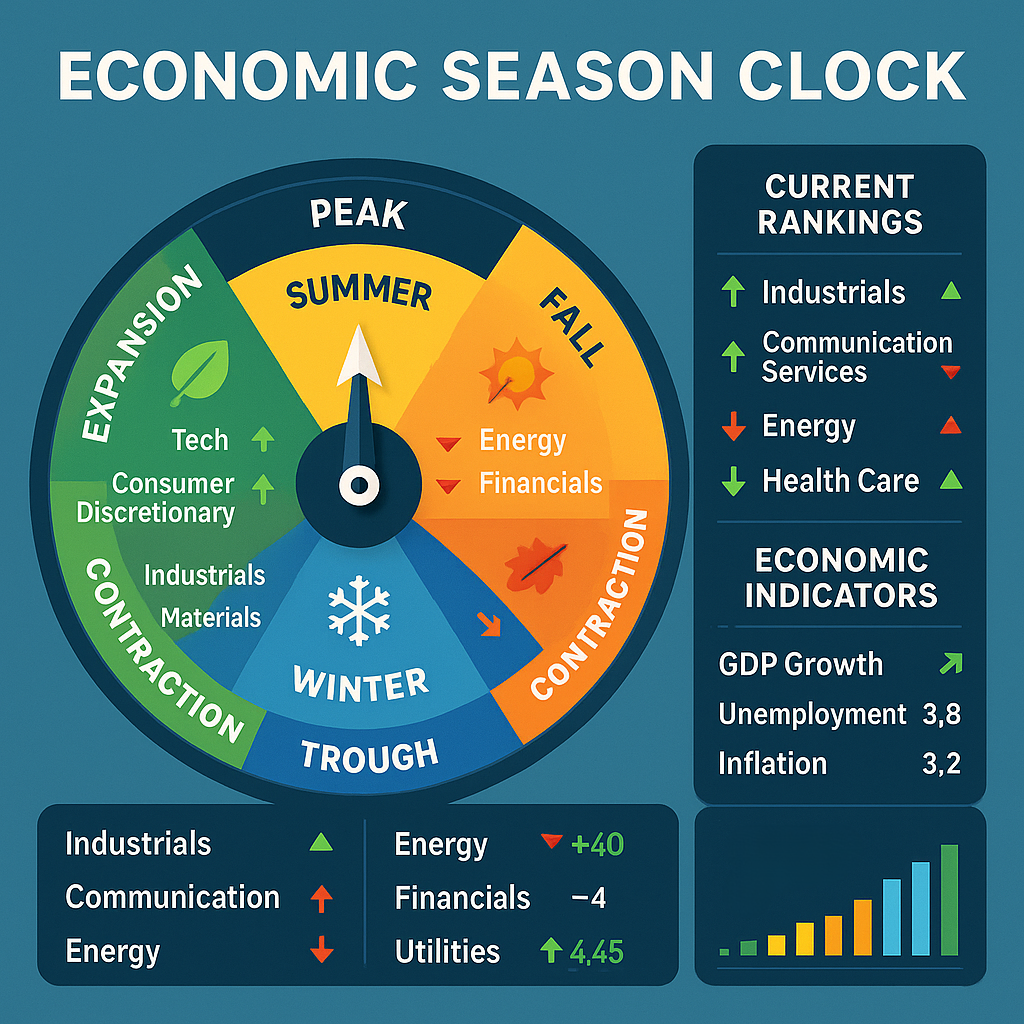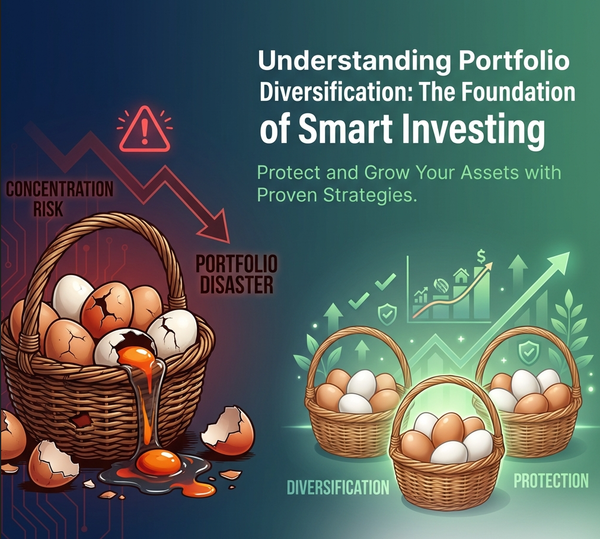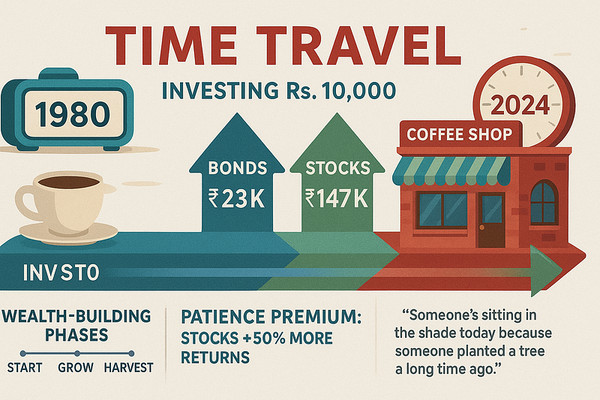The Sector Rotation Clock - Timing Your Way Through Economic Seasons
Navigate economic cycles with precision using sector rotation strategies that adapt to changing market conditions. Learn to identify optimal sectors for each economic phase and position your portfolio for the transition from late-cycle expansion to defensive positioning.

Just like you wouldn't wear summer clothes in winter, smart investors don't buy the same sectors in every economic season. Right now, the economic clock is pointing to a surprising investment opportunity.
The Story: Master gardener Elena knows exactly when to plant each crop: tomatoes in late spring, winter squash in summer, garlic in fall. She follows nature's cycle and harvests accordingly. Smart investors do the same thing with market sectors.
The Economic Season Clock:
Economic Spring (Early Recovery):
- Duration: 6-18 months after recession ends
- Characteristics: GDP growth accelerating, unemployment falling, confidence building
- Best Sectors: Technology, Consumer Discretionary, Financials
- Why: These are most sensitive to economic improvement
Economic Summer (Mid-Cycle Expansion):
- Duration: 12-36 months of sustained growth
- Characteristics: Full employment, capital spending boom, industrial activity peaks
- Best Sectors: Industrials, Materials, Energy
- Why: Infrastructure and commodity demand peaks
Economic Fall (Late Cycle):
- Duration: 6-18 months before recession
- Characteristics: Inflation rising, Fed tightening, growth slowing
- Best Sectors: Consumer Staples, Healthcare, Utilities
- Why: Defensive sectors provide stability as growth fades
Economic Winter (Recession):
- Duration: 6-18 months of contraction
- Characteristics: Unemployment rising, profits falling, fear dominating
- Best Sectors: Bonds, Cash, High-quality dividend stocks
- Why: Capital preservation becomes priority
Where Are We Now? (2025 Analysis) Current Economic Indicators:
- GDP Growth: 2.1% (slowing but positive)
- Unemployment: 3.8% (near full employment)
- Inflation: 2.4% (moderating but sticky)
- Fed Policy: Cutting rates but cautiously
- Market Valuation: Extremely expensive (P/E 27.6)
Clock Reading: Late Summer/Early Fall Translation: Transition from growth sectors to defensive sectors
Sector Performance by Economic Phase:
Current Sector Performance (2025 YTD):
Technology: +12.5% (still leading, but losing momentum)
Consumer Discretionary: +7.2% (benefiting from consumer spending) Industrials: +5.8% (infrastructure spending support)
Healthcare: +4.1% (defensive characteristics emerging)
Consumer Staples: +2.8% (steady as always)
Utilities: +0.5% (bond competition hurting)
Energy: +1.8% (commodity price stabilization)
The Rotation Strategy in Action:
Smart Money Movement (Current Trends):
Moving Out Of: High-growth technology (overvalued)
Moving Into: Healthcare, Consumer Staples (defensive positioning)
Watching: Financials (interest rate beneficiaries)
Avoiding: Real Estate, Utilities (bond competition)
Sector-by-Sector Analysis:
Technology (Proceed with Caution):
Current Status: Extended after AI boom
Valuation: P/E ratios 25-35+
Strategy: Take profits in overvalued names, keep quality leaders
Examples: Trim Tesla, hold Microsoft
Healthcare (Accumulate):
Current Status: Unloved due to regulatory concerns
Valuation: P/E ratios 12-18 (attractive)
Strategy: Build positions in quality pharmaceutical companies
Examples: Johnson & Johnson, Pfizer, UnitedHealth
Consumer Staples (Defensive Play):
Current Status: Boring but stable
Valuation: P/E ratios 18-22 (reasonable)
Strategy: Own for stability as growth slows
Examples: Procter & Gamble, Coca-Cola, Walmart
Financials (Conditional Buy):
Current Status: Benefiting from higher interest rates
Valuation: P/E ratios 10-15 (attractive)
Strategy: Buy quality banks with strong capital ratios
Examples: JPMorgan Chase, Bank of America
Energy (Cyclical Play):
Current Status: Stabilizing after volatile period
Valuation: P/E ratios 8-12 (cheap but cyclical)
Strategy: Small allocation to integrated oil companies
Examples: ExxonMobil, Chevron
Sector Rotation Timing Indicators:
Leading Indicators (Signal Coming Changes):
- Yield curve shape: Inversion signals recession ahead
- Fed policy shifts: Rate changes affect sector preferences
- Employment trends: Job growth/losses predict sector performance
- Consumer confidence: Spending patterns drive sector rotation
Lagging Indicators (Confirm Changes):
- Earnings revisions: Analyst estimates follow economic changes
- Sector relative performance: Price action confirms rotation
- Valuation spreads: P/E ratios adjust to new reality
The Rotation Portfolio Strategy:
Early Cycle Portfolio (25% allocation):
- Technology: 10% (growth leaders)
- Consumer Discretionary: 8% (spending recovery)
- Financials: 7% (credit expansion)
Mid Cycle Portfolio (40% allocation):
- Industrials: 15% (capital spending boom)
- Materials: 10% (commodity demand)
- Energy: 10% (infrastructure needs)
- Small-caps: 5% (economic expansion benefits)
Late Cycle Portfolio (35% allocation):
- Healthcare: 12% (defensive characteristics)
- Consumer Staples: 10% (recession-resistant)
- Utilities: 8% (bond-like stability)
- Cash/Bonds: 5% (capital preservation)
Sector Rotation Mistakes to Avoid:
Common Errors:
❌ Perfect timing obsession: Impossible to time exactly
❌ All-or-nothing approach: Gradual rotation works better
❌ Ignoring valuations: Cheap sectors in right cycle beat expensive sectors
❌ Following last year's winners: Performance rotates constantly
Smart Rotation Rules:
✅ Start rotation early: Markets anticipate economic changes
✅ Use gradual rebalancing: Shift allocations over 3-6 months
✅ Maintain quality focus: Best companies in favored sectors
✅ Keep some diversification: Don't abandon all sectors completely
Action Steps:
- Identify current economic cycle phase using multiple indicators
- Calculate your sector allocation vs. optimal for current phase
- Create rotation plan with target allocations
- Execute gradually over several months
- Monitor leading indicators for next rotation signals
Think About This: The best investors aren't fortune tellers - they're weather watchers who dress appropriately for each economic season. What season is your portfolio dressed for?
Master sector rotation with StockSageAI's economic cycle analysis and sector screening tools. Our platform tracks sector performance across market cycles, identifies optimal allocation strategies, and provides sector-specific screening capabilities across global markets. Access economic indicators, sector rotation signals, and portfolio rebalancing tools that help you stay ahead of market cycles. Time your sector investments like a professional at StockSageAI.com.




